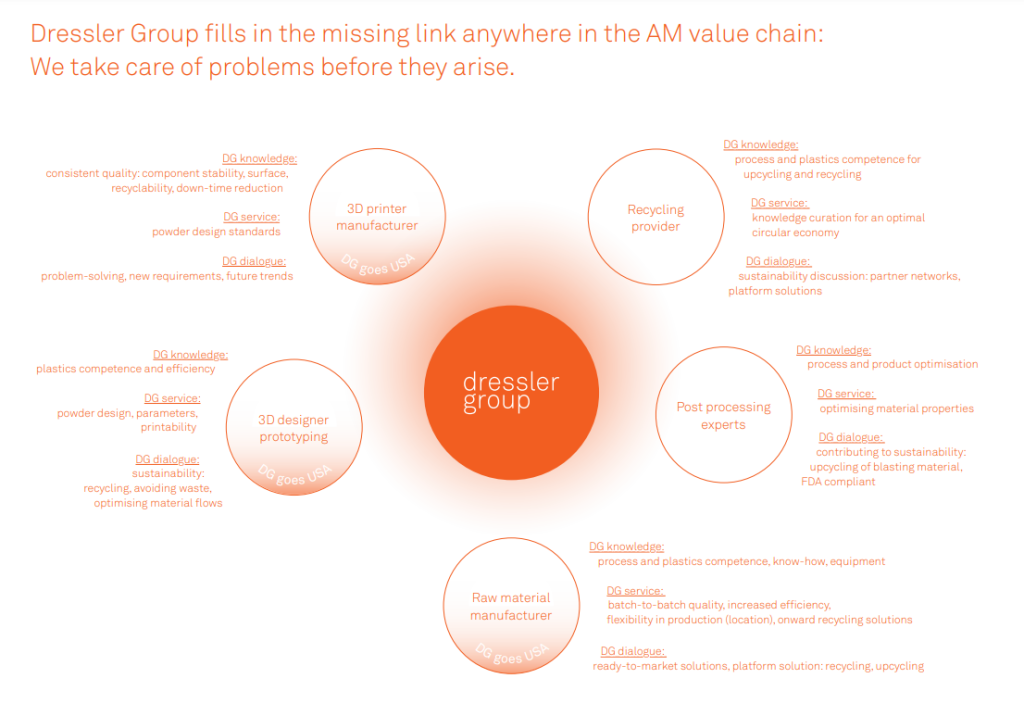Thermoplastic powder manufacturer Dressler Group (DG) demonstrated its ability to improve efficiency and quality for its customers, as well as serve as their personal driver of innovation, at Formnext 2022.
The company says it is committed to making the most of its resources and raw materials in all processes, whether developing individual powder solutions for customers or its own manufacturing plants and processes.
“With our new ‘grind your own powder’ approach, we guarantee our US customers that they will be able to produce any powder we have developed together in Meckenheim on their own premises in the future, using a DG plant configured especially for them. Just in time, in precisely the required quantity and, most importantly, in the accustomed Dressler quality every time,” said Jan Dressler, CEO of Dressler Group.

Dressler Group’s contributions to the additive manufacturing industry
Dressler Group believes that its 3D printing powder for medical and pharmaceutical technology and specialties provide benefits that go well beyond the specifications. For instance, the company claims to enable trouble-free processing on a large scale by maintaining consistent batch-to-batch quality. By ensuring the highest level of purity, DG’s custom powder designs provide greater stability and design freedom, as well as recyclability. Benefits include less material, less waste, and less energy consumption, also ensuring better integration into the circular economy.
DG has launched a new business segment in the 3D printing market that it describes as having “real game-changer potential.” Beginning in 2023, DG will offer Meckenheim’s complete “enabling package” to US customers, enabling them to create fully customized 3D printing powders themselves. A thorough needs analysis will be performed with the consumer to ascertain the specifics of their individual package. The advantages include independence from disrupted supply chains, scalable quantities up to industrial scale, maximum efficiency, reduced costs, and increased sustainability due to short distances.
The new DG Innovation Campus, which will open in spring 2023, will offer a new structure for Dressler Group’s theoretical and practical knowledge, particularly from the Technical Centre and Innovation Lab. This website is built on three pillars: DG Knowledge, DG Services, and DG Dialogue. Furthermore, the Campus will strengthen customer and supplier relationships, as well as collaboration with universities; it will expand the DG network and allow us to nurture and recruit young talent more effectively. The bottom line is that DG’s customers and partners gain a relevant and accessible knowledge advantage. This translates into very tangible benefits such as reduced risk, maximum resource efficiency, and powder reproducibility in any quantity at any time.

Sustainable side of additive manufacturing
Earlier this year, researchers at Heriot-Watt University published a study that calls into question some of the advantages that concrete 3D printing is widely thought to have over traditional construction methods. The researchers discovered that if a two-story structure built in the UAE using conventional precast concrete had been 3D printed instead, contractors would not have been able to accomplish the presumed efficiency gains. On the contrary, the team found that switching to 3D printing would have increased the project’s material costs by 44% while only yielding a minor improvement in sustainability.
Recently, EOS, the powder bed fusion (PBF) 3D printer developer, and Siemens, a global industrial manufacturing firm, both debuted novel sustainable 3D printing applications and powders at Formnext 2022. While Siemens showed how the inherent design freedoms of 3D printing can help decrease the footprint of automotive grippers, EOS introduced two eco-friendly materials. Previously powered by gasoline, the company’s carbon-reduced PA 2200 reportedly emits nearly 45% less CO2. EOS also released a climate-neutral PA 1101 that is bio-based without sacrificing quality.
Furthermore, researchers from Technische Universität Berlin (TU Berlin) and Brunel University developed a method for transforming 3D printed concrete into a more durable, eco-friendly building material. The team significantly improved the strength and thermal conductivity of concrete by partially substituting the sand in Portland cement with recycled glass, limestone, and plastic fillers. The engineers said that after using their novel material to 3D print chunks of wall, it could ultimately be used to construct the better-insulated buildings of the future with further R&D.
Follow this link for all the Formnext 2022 news.
To stay up to date with the latest 3D printing news, don’t forget to subscribe to the 3D Printing Industry newsletter or follow us on Twitter, or like our page on Facebook.
While you’re here, why not subscribe to our Youtube channel? Featuring discussion, debriefs, video shorts, and webinar replays.
Are you looking for a job in the additive manufacturing industry? Visit 3D Printing Jobs for a selection of roles in the industry.



